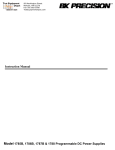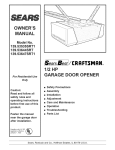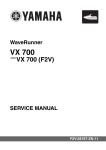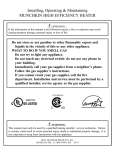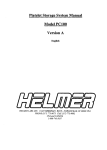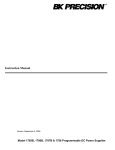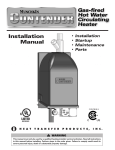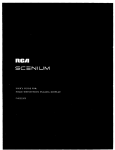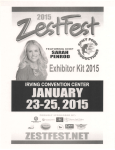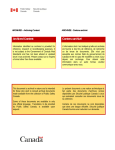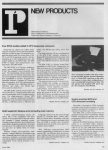Download Munchkin Gas-fired heater Operating instructions
Transcript
Installing, Operating & Maintaining
MUNCHKIN HIGH EFFICIENCY HEATER
If the information in this manual is not followed exactly, a fire or explosion may result
I causing property damage, personal injury
z_ WARNING:
or loss of life.
Do not store or use gasoline or other flammable
in the vicinity of this or any other appliance.
WHAT TO DO IF YOU SMELL GAS
vapors and liquids
• Do not try to light any appliance.
• Do not touch any electrical switch: do not use any phone in
your building.
• Immediately call your gas supplier from a neighbor's phone.
Follow the gas supplier's instructions.
• If you cannot reach your gas supplier, call the fire department.
Installation and service must be performed by a qualified
installer, service agency or the gas supplier.
CONTROLS
C
US
_WARNING:
This manual
to comply
must only be used by a qualified
could result in severe personal
also important
to keep these Instructions
heating
installer
/ service
injury, death or substantial
with the appliance.
HEAT TRANSFER
PRODUCTS,
INC.
120 BRALEY RD., E. FREETOWN,
MA
02717
technician.
property
Failure
damage.
It is
TABLE OF CONTENTS
PART 1
GENERAL
1-A.
l-B.
1-C.
INFORMATION
HOW IT OPERATES .........................................................
LOCATION ........................................................................
PRESSURE RELIEF VALVE ............................................
I
2
2
PART 2
2-A. ELECTRICAL
CONNECTION
........................................
2
PART 3
3-A. GAS CONNECTION .........................................................
3-B. GAS PIPING ......................................................................
3-C. GAS TABLE ......................................................................
3
3
3
PART 4
VENTING
4-A.
4-B.
4-C.
4-D.
4-E.
4-F.
ALL MODELS 3" VENTED ............................................. 4
FOR LONGER VENT LENGTHS .................................... 5
VENTING TABLE .........................................................
5-6
CLEANER/CEMENT ........................................................
6
CONDENSATE ..................................................................
6
VENTING TABLES ..........................................................
7
PART 5
5-A. HYDRONIC HEAT PIPING .............................................. 8
5-B. FILL AND PURGE HEATING SYSTEM ......................... 8
PART 6
BOILER START LIP
6-A. COMMON VENT TEST ...................................................
6-B. ITEMS TO BE CHECKED BEFORE
LIGHTING THE MUNCHKIN .......................................
6-C. LIGHTING INSTRUCTIONS .........................................
9
10
11
PART 7
SERVICING
7-A. SEQUENCE OF OPERATION ....................................... 12
7-B. ADJUSTMENT SET POINTS
AND DIFFERENTIAL SETTINGS ................................ 12
7-C. MUNCHKIN BOILER FAULT LED CODE .................. 13
7-D. FAULT CONDITIONS ............................................... 13-14
PART 8
8-A. MAINTENANCE PROCEDURES ................................. 15
8-B. BEFORE EACH HEATING SEASON ........................... 15
8-C. COMPONENT DIAGRAM ............................................. 16
I
THIS UNIT
IS FOR
APPLIANCE,
THIS
INSTALLATION
"NATIONAL
APPLY
•
CATEGORY
COMBUSTION
HEATER
FUEL
GAS
THE
CODE"
Section
FIRED
GAS
CONFORM
ANSI
Z223.1
PRACTICES
AND
IF THE
ONLY.
TO THE
STATE
AND
THIS IS A SEALED
LATEST
LOCAL
EDITION
CODES
OF THE
MIGHT
ALSO
HAVING
JURISDICTION,
THE INSTALLATION
FOR CONTROLS
AND SAFETY
DEVICES
FOR
ANSI/ASME
OR EXPLOSION
INJURY,
OR DEATH.
DO NOT
STORE
WATER
CODE
AND
IN THESE
MAY
BOILER
RESULT;
OR ANY
VENTING
PERSONNEL
LICENSING
INSTRUCTIONS
OR USE GASOLINE
OF THIS
PIPING,
& QUALIFIED
LOCAL
INFORMATION
VICINITY
BOILERS,
PIPING,
BY TRAINED
THE
- 2 PIPE
AND
PRESSURE
VESSEL
IV.
HEATER,
INSTALLED
FIRE
•
MUST
WHERE
REQUIRED
BY THE AUTHORITY
MUST CONFORM
TO THE STANDARDS
CODE,
•
IV VENTING
TO INSTALLATION.
AUTOMATICALLY
•
CAUTIONS
WARNINGS
CAUSING
OR OTHER
OTHER
AND
ELECTRICAL
FAMILIAR
MUST
WITH
BE
INSTALLATION
REQUIREMENTS.
ARE
NOT
PROPERTY
FLAMMABLE
FOLLOWED
DAMAGE,
VAPORS
EXACTLY,
A
PERSONAL
AND
LIQUIDS
IN
APPLIANCE;
WHAT TO DO IF YOU SMELL GAS:
Do not try to light any appliance:
Do not touch any electrical switch: do not use any phone in your building:
Immediately call your gas supplier from a neighbors' phone:
Follow the gas suppliers' instructions"
If you cannot reach your gas supplier, call the fire department:
Installation and service must be performed by a qualified installer: service agency or the gas supplier.
PART 1
GENERAL
INFORMATION
1-A. HOW IT OPERATES
When the room thermostat calls for heat, the Munchkin control board will start the pump and start to monitor the return
temperature of the system before the heater will begin to heat the water. Once the controller has sensed a drop in the return
water temperature below the temperature set point minus the differential set point, the boiler will start to heat the water. This
eliminates the Munchkin starting every time the thermostat calls for heat. This feature keeps the system from short cycling.
Once the system has sensed the temperature difference, the Mnnchkin will activate the blower motor for 5 seconds to prepurge
the system before starting the Munchkin. The Munchkin controller will now start to modulate the pre-mix burner based on
analyzing the turn temperature, supply water temperature, and the set point temperature. By compiling this information, the
controller utilizes an algorithm to fully adjust the firing rate while maintaining the desired output temperature. The pre-mix
burner fans have a low-voltage direct current drive motor with a pulse relay counting. This system allows precise control over
the fan speed and combustion air volumes. Coupled with the Honeywell gas valve and the Venturi system set to provide a
one-to-one ratio of precisely measured volumes of fuel to air, accurate and instant burner output is achieved. This keeps the
Munchkin running at the highest elTleiency.
When the thermostat is satisfied, the Munchkin will then go through a 4 second post-purge cycle before shutting off. Every
Munchkin heater is equipped with an indicator light which will pulse constantly in normal operation. When a problem occurs,
the indicator light will blink slowly to indicate the heater fault.
I-B.
LOCATION
_WARNING:
MUNCHKIN MUST BE SET ON A LEVEL SURFACE SO
CONDENSATION DOES NOT BACK UP INSIDE BOILER.*
The Munchkin is designed for Installation on combustible flooring, in alcoves, basements, closets, utility rooms. The
Mnnchkin shall be installed so that the gas ignition system components are protected from water. This includes all related
piping and components.
Choose a location for your Munchkin, centralized to the piping system, along with consideration to vent pipe length. As the
length of vent pipe increases the firing rate of the Munchkin decreases. You must also locate the Munchkin where it will not
be exposed to freezing temperatures. Additionally, you will need to place the heater so that the controls, inletJoutlet, and gas
valve are easily accessed. This Munchkin must not be installed outdoors, as it is certified as an indoor appliance, and must be
kept vertical and on a level surface. Also, care must be exercised when choosing the location of this appliance; where leakage
from the relief valve, from related piping will not result in damage to the surrounding areas or to the lower floors of the
building. A heater should always be located in a area with a floor drain or installed in a suitable drain pan. Proper
clearance must be provided around the Munchkin as follows: Sides, bottom, top, and back are 0" (zero clearance). Venting is
also zero clearance. Front of the appliance needs 4" service clearance minimum. This front service may be achieved by a nonrated or combustible door or access panel; providing the 4" front, 15" on top, and 16" either side service clearance is achieved
when the front cover is removed. Under no circumstances, shall Heat Transfer Products Inc. be held liable for any such
water damage whatsoever. This heater must not be located near flammable liquids such as gasoline, adhesives,
solvents, paint thinners, butane, liquefied propane, etc.; as the controls of this appliance could ignite those vapors,
causing an explosion.
1-C. PRESSURE
RELIEF
VALVE
A pressure relief valve is installed into the front right side manifold we recommend a WATTS ¾"M 335 MI valve or
equivalent and meets the requirements of ANSI/ASME Section IV for heating boilers. A 3A"pipe must be directed to a floor
drain or suitable location within 6" of drain or floor. Protect from freezing, do not plug or cap pressure relief valve. Serious
explosion causing property damage and or loss of life could result. Under no circumstances should the relief valve be
eliminated, capped or plugged.
SERVICING
- _
WARNING
-
CAUTION
Before servicing let the munchkin cool down! Shut off electrical and gas supply.
Failure to follow warning could result in severe burn, electrical shock, gas
leakage, fire or explosion.
PART 2
2-A. ELECTRICAL
CONNECTION
The electrical connection for the Munchkin is on the left side of the unit. There is a t½,,knockout location for electrical
connection. All electrical wiring must be performed by a qualified licensed electrician, and in accordance with National
Electrical Code, or to the applicable local codes and standards. For your convenience we have labeled all the wire which needs
to be connected to operate the Munckin. Caution: Do not remove labels on wires prior to disconnection. The electrical
requirements are for standard 120 volts, 60 Hz 10 amp service. This unit must be wired with #14 awg, and fused for no more
than 15 amps. It is of extreme imnortance that this unit be nronerlv _rounded! There are two ground points in the
electrical compartment that must be connected to the building ground system. Connect the building to the green ground screw
and the green ground wire. It is very imnortant that the buildin_ system around is insnected by a uualified electrician.
prior to makin_ this connection.
The black wire is the hot lead and white wire is the neutral lead. Once all connections have been made the electrical
access may be closed. It is very imnortant that the electrical nower is not turned on at this time! A green LED is
provided on the main control board. This LED must be illuminated when the Mnnchkin is turned on for proper
operation.
2
DIAGRAM
"A"
WIRINGOJAGP,AMCONNEC'FINGTO I NI_RNAL_Lr;4p RELAy
DIAGRAM
"B"
WIRING DIAGIr_f4 WITHOUTCONN_CllON TO INTERN_,.FUNpRELAy
RED (NOT USED)
NORMALLY OPEN
TH_RM STAT
CONNeCtiON
GRAY
WH_
BLACK
W
(HOT)
GROUND
SCREW
GROUND
SCREW
MUN_KIN
ELECTRICAL
SWITCH 3U NCTJON BOX
12QV 6O HZ
PART 3
3-A. GAS CONNECTION
_RVlCE
S_ll_ CCr V_-VE
lie _1
Gas supply shall have a maximum inlet pressure of less than 14" water column Mt_T
LUST _/_' Lp_
(350 ram), ½ pound pressure (3.4 kPa), and a minimum ofT' water column.
The entire piping system, gas meter, and regulator must be sized properly to
prevent pressure drop greater than 0.5" as stated in the National Fuel Gas Code.
_Ep t_
This information is listed on the rating plate. It is very important that yon are
connected to the type of gas as noted on the rating plate. "LP" for liquefied
petroleum, or propane gas; or "Nat" natural gas or city gas. All gas connections must
be approved by the local gas supplier, or utility in addition to the governing authority, prior to turning the gas supply on. The
nipple provided is ½", and it is mandatory that a %" to ½" reducing bushing (provided) is used, threaded into the branch of a
%" tee, and a drip leg fabricated, as per the National Fuel Gas code. You must ensure that the entire gas line to the
connection at the Munchkin is no smaller than 3/4". Once all the inspections have been performed, the piping must be leak
tested. Iftbe leak test requirement is a higher test pressure than the maximum inlet pressure, you must isolate the Munchkin
from the gas line. In order to do this, you must shut the gas off following lighting instruction on page 11. Unscrew the
threaded mounting flange which is located on the gas valve which will prevent high pressure which may damage the gas
valve. In the event the gas valve is exposed to a pressure greater than ½ PSI, 14" water column, the gas valve must be
replaced. Never use an onen flame (lit match, li_hterI to check _as connections.
3-B.
GAS PIPING
WARNING
Failure
2.
3-C,
to follow
all nrecautions
could result
in fire. explosion
or death!
Run gas supply line in accordance with all applicable codes.
Locate and install manual shutoff valves in accordance with state and local requirements.
1.
GAS TABLE
Refer to Table (1) to size the supply piping to minimize pressure drop between meter or regulator and unit.
Maximum Capacity of Pipe in Cubic Feet of Gas per Hour for Gas Pressures of 0.5 psi or Less and a Pressure Drop of 0.3
Inch water Column
(TABLE 1)
(Based on a 0.60 Specific Gravity Gas)
Nominal
Iron Pipe
Size
(inches)
3/4
1
1 1/4
1 1/2
Internal
Diameter
(inches) 10
.824
278
1.049
520
1.380 1,050
L610 1,600
Length of Pipe (Feet)
20
190
350
730
1,100
30
152
285
590
890
40
50
130 115
245 215
500 440
760 670
60 70
105 96
195 180
400 370
610 560
80
90
170
350
530
90
84
160
320
490
100
79
150
305
460
125
72
130
275
410
150
64
120
250
380
175
59
110
225
350
200.
55}
100}
210}
320}
BTU'S
PER
HOUR
X1,000
It isrecommended
thatasoapy
solution
beused
todetect
leaks.Bubbles
will appear
onpipetoindicate
aleakispresent.
The
gaspipingmustbesizedfortheproperflowandlengthofpipe,toavoidpressure
drop.Boththegasmeterandthegas
regulator
mustbeproperly
sized
forthetotalgasload.If youexperience
apressure
dropgreater
than1"WC,themeteror
regulator
orgaslineisundersized
orinneedofservice.Youcanattach
ametertotheincoming
gasdripleg,byremoving
the
capandinstalling
themeter.The gas pressure must remain between 7" and 14" during stand-by and unit running heat cycle.
If an in-line regulator is used, it must be a minimum of 10 feet from the Manchkin. It is very important that the gas line is
properly purged by the gas supplier or utility. Failure to properly purge the lines or improper line sizing, will result in
the failure of the Munehkin lighting off. This problem is especially noticeable in NEW LP installations, and also in empty
tank situations. This can also occur when a utility company shuts off service to an area to provide maintenance to their lines.
This valve must not be replaced with a conventional valve under any circumstances. As an additional safety feature, this
valve has a flanged connection to the Venturi and blower.
PART 4
VENTING
4-A. ALL MODELS 3" VENTED
WARNING!!
[t is extremely important to follow these venting instructions exactly. Failure to
follow the venting instructions can cause severe personal injury, death or
substantial
property
damage.
The inlet pipe on the back of the cabinet, use 3" PVC schedule 40. It is very important that you plan the location properly, to
eliminate long pipe runs and excessive fittings. Inlet pipe size must not be reduced. Do not combine the inlet air with any
other inlet pipe including an inlet to an additional similar appliance. The joints must be properly cleaned, primed, and
cemented. The piping must also be properly supported as per Local and National Standard Plumbing Codes. It is important
that the piping must be clean and free from burs, debris, ragged ends, and particles of PVC.
Exhaust pipe on the back of the cabinet will use 3" PVC Schedule 40. For concrete construction or to meet certain fire codes,
exhaust piping inlet air pipe must be 3" CPVC Schedule 40 or 80, (only to meet local fire codes). The balance of the inlet and
exhaust piping may be PVC Schedule 40 or 80, orABS solid only, NOT FOAM CORE.
The only approved exhaust vent materials are PVC Schedule 40 (NOT FOAM CORE PIPE!). Exhaust piping should be
sloped back to the connection on the Munchkin, at least %" per foot to remove additional condensate that forms within the
pipe. The total combined length of pipe (intake piping plus exhaust piping added together) including elbow allowances intake
and exhaust (each elbow = 5' of pipe) should not exceed 85'. The combined vent length should not be less than a combined
length of 6' plus two 90 degree elbows. Choose your vent termination locations carefully. You must additionally make certain
that exhaust gas does not re-circulate back into the intake pipe. You must place them in an open area, and follow the
following guidelines.
1)
2)
3)
4)
5)
6)
7)
8)
9)
10)
il)
Never vent into a walkway, patio area, alley or otherwise public area less than 7' from
the ground;
Never vent over / under a window or over a doorway;
Never install a heat saver or similar product to capture waste heat from exhaust;
Always have vent location at least 1' above maximum snow level;
Always have vent 1' above ground level, away from shrubs and bushes;
Follow local gas codes in your region or refer to National Fuel Gas Code, Can B149;
Always have vent at least 3' from an inside comer of outside walls;
Maintain at least 4' clearance to electric, gas meters, and exhaust fans or inlets;
Very lmoortant!
Inlet air must be taken from outside of building, next to exhaust
outlet, no closer than 8";
Always place screens in all openings in intake and exhaust to prevent foreign matter
from entering the Munchkin.
The vent intake and exhaust must be properly cleaned and glued, for pressure tight joint. Several methods
for venting the Mtmchkin can be found in Figures 1 thru 6. Use the following layout as a guideline; certain
site conditions such as multiple rooflines/pitcbes may require venting modifications-cnnsult factory. The
air inlet must be a minimum of 1' vertically above the maximum snow level or 24" which ever is greater.
The air inlet must also be a minimum of 10' horizontally from the roof, and terminated with a tee. The
exhaust must be a minimum of 24" above the air inlet opening, and terminated with a coupling. It is very
important that there are no other vents, chimneys, or air inlets in any direction for at least 4'. All
4
12)
venting must be properly supported, as the Munchkin is not intended to support any venting
whatsoever. All piping, glue, solvents, cleaners, fittings, and components, must conform to ASTM
(American Society for Testing and Materials), andANSI (American National Standard Institute).
It is recommended that you use one of the optional vent kits specifically for Munchkin
installations.(KGAVT0601CVT (3 in.) or V 1000). NOTE: WHEN USING THE HGAVTT601CVT KIT,
REMOVE THE 2 SCREENS FROM THE PROVIDED INLET TEE, AND INSTALL THEM IN THE
INLET SOCKET AND OUTLET SOCKET OF THE KIT PRIOR TO INSTALLING THE SCHEDULE
40 PIPE AND GLUING
4-B. FOR LONGER VENT LENGTHS
All venting must be 3", both intake and exhaust, NEVER use any piping less than 3", or different size pipe on the intake
and exhaust. You may use 4" venting on both intake and exhaust, to lower the pressure drop, to provide additional venting
length. It is imperative when using 4", to follow these instructions very carefully. For longer lengths, the first 10' of
both the intake and exhaust piping are 3". For the intake 10' of 3" PVC Schedule 40 pipe plus one 90 degree or two 45
degree elbows and for the exhaust 10' of PVC Schedule 40 pipe, NOT FOAM CORE, or CPVC plus one 90 degree or
two 45 degree elbows. Then use a 4" x 3" PVC reducing coupling. Then proceed with PVC 4" (NOT FOAM CORE) pipe
and fittings for both the intake and exhaust piping. On 4" piping you may go an additional 125 equivalent feet of pipe and
fittings, combined total length. The 4" fittings have a friction loss allowance as follows: 4" 90 degree = 3', and a 4" 45 degree
= 1'. The total maximum venting length can be 125', plus the first 10' of each 3", and a maximum fitting allowance of
the 3", total two 90 degree or four 45 degree before increasing to 4". Total equivalent would be 30' of 3" plus 125' of 4".
Never use different pipe sizes for intake and exhaust. The vent system must be balanced by friction loss equivalent.
NOTE:
THE
METHODS
DESCRIBED
ARE
SUGGESTED
GENERIC
JOB SITE OBSERVATIONS
AND SIZING MAY REQUIRE
METHODS.
CONSULT
THE FACTORY
WITH SPECIFIC
ADDITIONAL
RECOMMENDATIONS.
4-C.
VENTING
METHODS
ONLY.
SPECIFIC
ALTERNATE
INSTALLATION
JOB REQUIREMENTS
FOR
TABLE
Note: Do not exceed the total combined length of pipe (intake piping plus exhaust piping added together) including fitting
allowances shown below should not exceed 85'. The table shows the friction loss for plastic pipe and fitting in 3" and 4" sizes.
FRICTION
LOSS EQUIVALENCE
TABLE
JOB EXAMPLE:
Note: this example totals both intake and exhaust piping.
4pcs.-3"90=20'
; 20' -3"PVCSCH.
40PIPE=20'
40' Total combined length is under max allowable vent run of 85'
This job is okay!
(AFTER
3" VENTED
MODELS
TABLE EQUIVALENT
FITTING
DESC.
3" 90
3" 45
3" COUPLING
3" TEE
3" PIPE
3' CONCENTRIC
VENT KIT
3' V1000 VENT KIT
EQUIVALENT
FEET
OF PIPE
5'
3'
0'
0'
1'=1'
3'
0'
I[
THE FIRST 10' OF 3" ONLY) ]
4" VENTED MODELS
I
EQUIVALENT
TABLE
]
FITTING
DESC.
4" 90
4" 45
4" COUPLING
4" PIPE
4" TEE
EQUIVALENT
FEET OF
PIPE
3'
1'
0'
1'=1 '
0'
VENTING
EXAMPLES
TOTAL
COMBINED
VENTLENGTH
/FEET)
QTY.
INTAKE
&
OF90*
EXHAUST ELBOWS
EQUIVALENT
FRICTION TOTAL
LOSS
FRICTION
(FEET)
LOSS
FOREACH FOR
ELBOW
ELBOWS
GRAND
TOTAL
VENTLENGTH
(FEET)
WITHFITTING
FRICTION
LOSS
ADDED
'12
20
20
20
20
20
20
20
20
20
30
30
30
30
30
30
40
_0
_0
_0
50
50
5
5
5
5
5
5
5
5
5
5
5
5
5
5
5
5
5
5
5
5
5
5
22
30
35
40
45
50
55
60
65
70
45
50
55
60
65
70
55
60
65
70
65
70
4-D. CLEANER
2
2
3
4
5
6
7
8
9
10
3
4
5
6
7
8
3
4
5
6
3
4
10
10
15
20
25
30
35
40
45
50
15
20
25
30
35
40
15
20
25
30
15
20
/ CEMENT
Cement for Exhaust and Intake piping, must conform to ASTM D-2564 for joining PVC joints. Make sure to check all joints
to assure that they are properly sealed against leaks. It is important to pay special attention to the exhaust piping, which is
pressurized with harmful gases!
4-E. CONDENSATE
This is a condensing high efficiency appliance, therefore this trait has a condensate removal system. Condensate is nothing
more than water vapor, derived from the combustion products, similar to an automobile when it is initially started. This
condensate does have a low PH and should be treated with a condensate filter. This filter contains either lime crystals or
marble crystals, which will neutralize the condensate. The outlet of the filter is sized for 5/8" ID (Inside diameter) plastic
tubing. It is very important that the condensate line is sloped away from and down to a suitable inside drain, if the condensate
outlet on the Munchkin is lower than the drain, you must use a condensate removal pump. A condensate filter and a
condensate pump kit are available from HTP. It is also very important that the condensate line is not exposed to freezing
temperatures, or any other type of blockage. Plastic tubing should be the only material used for the condensate line: as steel,
brass, copper, or others will be subject to corrosion and deterioration. A second vent may be necessary to prevent condensate
line vacuum lock ifa long horizontal rtm is used. Also an increase to 1" tubing may be necessary.
VENTING
DIAGRAMS
4-E
WALL
-%
W_KH
I_
MUtiC_(IN BOILER
INT_
3" SIDEVALL
3"
SIDEVALL
VENT
_41TH TEE
(INTAKE)
I, COUPLING
(EXHAUST)
VENT VITH
aoamm]
TEE (INTAKE)
m_
W I_a_
& CDIJPI_ING (EXHAUST)
gIGtJRZ 2
m,IMPORTANT NOTE] ALL VENT PIPES MUST BE GLLICD, PRDPERLY
SUPPDRTED, ANI) THE EXHAUST MUST BE PITCHE]3 A MINIU
OF
A 1/4" PER FDQT BACK TO THE BDIL[R (T(] ALL[_ ,t _AINAC_E QF CDN]!]EK_'-_TE)mm
FIGURE 1
mmIMPDRTANTNDTEI ALL VENT PIPES MUST BE GLUED, PRQFtZRLY
SUPPQRTED, ANI) THE EXHAUST MU_T BE PITCH£I} A MINIMUM DF
A 1/4" PER F{]DT BACK TO THE Bf]ILER (T{] ALLDV DRAINAGE DF EDNI)EN_ATE)mm
s'n_ cmmu_
WALL
_C:,fKI_
ECtLER
vIooo
wJ_r Kff
--1
rm _q_
k,u4cm_ w
o_
J
3 ° $11)EVALL VENT VITH V1000 KIT
FIGLIR£ 3
uuINPDRTANT NQTE, ALL VENT PIPES MUST BE GLUED, PROPERLY
SUPPDRTES. AND THE EXHAUST MUST BE PITCHED A MINIMUM OF
A 1/4" PER FODT BACK TD THE SDILER (TQ ALLDV DRAINAGE DF EDNgENSATE)um
3" _
VI_NT
VITH
TIE[ (It4TAKI_)
rlr.dJ_[
A
_/4"
L C01_'_t.IM_
(I_T)
4
.uINFI_T_T
WOT£, _
Vf:WT I_$
14U_T K
6LtE_
I_¥
SUPP(]_Tgg,
_
THE CXN_U_T HU_T K
pITC;4ED
A )_NINUN OF
p_R rOOT _
TO TH[ IO_.£R
(T0 _d-LOW" _
(Ire 1:_4]W:N_TIE)UE
W_LL
t, m
wE_w
3" SII_VALL
VENT VITH 3 ° CDNCENTRIE
VENT KIT (KGAVTO6OtCVT)
FIGURE 5
.mIMPQRTANT NOTE. ALL VENT PIPES MUST BE GLUEg, PRDP_NLY
SUPPORTEg, aN9 THE EXHAUgT MUST BE PITCHED /_ NININUN Dr
A I/4" PER FDDT BACK TD TI_ _QILER (TD ALLI]V SNAINAGE OF EDNgEN$_TE..u
3° _
VENT VITIt
3_ CI]_ENTRIC
VENT
KIT (KGAVT0_01CVT)
gIC_JRE6
mlIDtFI]RT/elT
ND't£. N.L VENT PIPITS 14i_T II_ C.LtJ_J, PR[Ia_RLY
SUPPORTED, N_ PITCHES /_ NININUN OF" /_ _J_RTER INCH _
rOOT
II_CK TO THE E_ILER (Tfl /_LL0V _R_I_
OF- CON_NSAT[_m
7
PART 5
5-A. HYDRONIC
HEAT PIPING
The Munchkin is designed to function in a closed loop 15 PSI System. To assure that there is adequate pressure in the system,
we have installed in the Outlet Manifold, a pressure switch which will not let the Mnnchkin operate without a minimum of 10
PSI water pressure. This assures that the system does not have a leak, which could cause damage to the Munchkin System. It
is Important to note that the Munchkin Boiler does have minimal amount of Pressure drop and must be figured in when sizing
the circulator to the System (See Figure 7B). Each Munchkin System must have an Air Eliminator which is designed to be
installed in the Boiler Return Pipe (boiler in) which will remove air from the Hydronic System. Always follow good piping
practices. Observe minimum 1" clearance to combustibles around all uninsulated hot water pipes, or when openings around
pipes are not protected by non-combustible materials. On a Munchkin installed above radiation level, some states and local
codes require a low water cut off device at the time of installation by the installer. If the Manchkin supplies hot water to
heating coils in air handlers units, flow control valves or other devices must be installed to prevent gravity circulation of boiler
water in the coils during the cooling cycle.
CAUTION! !
THE MUNCHKIN
SHOULD NOT BE OPERATED AS A PORTABLE HOT WATER HEATER.
IT IS NOT TO BE USED AS A DIRECT DOMESTIC HOT WATER APPLIANCE.
Basic steps are listed below, with an Illustration, which will guide you through the installation of the Munchkin
1. Pipe properly. In accordance to (Figure 7A).
2. Connect system return marked "BOILER IN". make sure to install with pipe sealant compound. Threaded connection are
1¼" NPT brass nipples.
3. Connect system supply marked "BOILER OUT". Make sure to install with pipe sealant compound. Threaded connection
are 1¼" NPT brass nipple.
4. Install Pur_e and Balance Valve on system return.
5. Install Back Flow Preventer if required by local codes on system return.
6. Install Pumo on system supply. Make sure pump is properly sized for piping loss.
7. Install on Cold Water Feed Pressure Reduein_ Valve. (15 PSI nominal on system return). Check temperature/pressure
gauge should read minimum of 12 PSI.
8. Install Exnansion Tank on system supply. Use appropriate size tank for volume of water in system.
9. Install Air Vent on system return.
10. Install _
on system supply.
11. Install _
on system supply. Note Mnnchkin can not be drained of water without purging the unit with air
pressure 15 PSI minimum.
12. Install Temperature/pressure gauge on system supply.
5-B. FILL AND PURGE HEATING
SYSTEM
Attach hose to balance and purge hose connector and run to drain.
Close the other side of the balance and purge valve.
Open first zone balance and purge valve, so as to let the water flow out of the hose. If zone valves are used, open zone
valves one at a time, manually. (NOTE: please check manufacturers' instructions prior to opening valves manually, so
not to damage valve.)
Manually operate fill valve regulator. When water runs out of hose, connected to the balance and purge valve, in steady
stream (with no air bubbles), close balance and purge valve to stop the water from flowing. Disconnect hose and
connect to next zone to be purged.
Repeat procedure for additional zones (one at a time).
Upon completion, make sure that the fill valve is in automatic position and each zone balance and purge valve is in the open
position and zone valves are positioned for automatic operation.
I
NOTE: Installation that incorporate Standing Iron Radiation and systems manual vents high points. Follow the above
procedure than slatting with nearest manual air vent, open vent until water flows out; close vent. Repeat procedure, working
your way toward furthest air vent. It may be necessary to install basket strainer in older hydronic system where larger
amounts of sediment may be present. Annual cleaning of the strainer may be necessary.
SUGGESTED
_
_
HYDRON1C
PIPING FOR MUNCHK1N
FIGURE 7A
SYSTEM
R--N
PUMP
_ I_BACK
:_ _)LOW
BOILER
FLOW pREVENTER
PRESSURE
FEED (15
_
G_S
9URN[_
EMERGCNCy
SV[TCH
_
LB NOMINAL)
_IILER
_
_
EXPANSION
TANK
C0kD_
0 0 s_
IN
_C]LER
& BALANCE
VALVE
_ {_PURGE
_AIREl iminator
VENT
(Mir RecoHended)
co bubbler
• _ FLOW CHECK
• _
_
I_RAIN
SYSTEM_
S_LY_
Air
_h_KIN
HOT
RETURN
--__um
pipe
PORt
COLD
OdTL£T
EXHAUST_
V&LVE
yEMPERATURE
& PRESSURE
GAGE
F_,DNT
_I_"UNION
• ITERS
SUPPLIED
CDNNECT
BY CONTRACTOR
TD
ALL PIPES _ST
BDILER
SUPPLY
I_ PR_Ly
HOT
SLPpDR?Eg
CEINNEOT
TO
_LL PIPC$ _Sl
BDILER
K
p_RLV
RETURN
CQLD
SUpt'flRTE_
BACK
NOTE: BOILER CONNECTIONS
ARE 1 I/4"NPT
FIGURE
7B
21.
20.
F
19 ,
18"
C
T
t
O
N
17"
16,
15,
14
13'
12"
11
10"
9
8'
7
6
5
4
3
2
1
1 2 3 4 5 6 7 B g 10 11 12 13 14 15 16 17 18 1920 21 22 23
FLOW IN GALLONS PER MINUTE
TACOpRd
MUNCHKIN 80M
00"/'(_)
MUNCHKIN 140M
MUNCHKIN 199M
1) THE RECOMMENDED
_
_
0010V)
0011(1)
GRUNOFOS
p,_I
15-42.F 8po-2
26"64F
26-116F
CIRCULATORS ARE BASED ON 1 GPM PER 10,000 BTU/HR W/20° At
PART 6
BOILER START UP
6-A. COMMON
VENT TEST
At the time of removal of an existing boiler, the following steps shall be followed with each appliance remaining connected to
the common venting system placed in operation, while the other appliances remaining connected to the common venting
system are not in operation.
1. Seal any unused openings in the common venting system.
2. Visually inspect the venting system for proper size and horizontal pitch and determine there is no blockage or
restriction, leakage, corrosion and other deficiencies which could cause an unsafe condition.
3. Insofar as the practical, close all building doors and windows and all doors between the space in which the appliances
remaining connected to the common venting system are located and other spaces of the building. Turn on clothes
dryers and any appliance not connected to the common venting system. Turn on any exhaust fans, such as range hoods
and bathroom exhausts, so they will operate at maximum speed. Do not operate a summer exhaust fan. Close fireplace
dampers.
BfllLER
4,
Place in operation the appliance being inspected.
operate continuously.
5.
Test for spillage at the draR hood relief opening aRer 5 minutes of main burner operation. Use the flame of a match or
candle, or smoke from a cigarette, cigar or pipe.
After it has been determined that each appliance remaining connected to the common venting system properly vents
when tested as outlined above, return doors, windows, exhaust fans, fireplace dampers and any other gas-burning
appliance to their previous condition of use.
Any improper operation of the common venting system should be corrected so the installation conforms with the
National Fuel Gas Code, ANSI Z223.l. When resizing any portion of the common venting system, the common
venting system should be resized to approach the minimum size as determined using the appropriate tables in Appendix
G in the National Fuel Gas Code, ANSI Z223.1
6.
7.
6-B.
ITEMS
TO BE CHECKED
READ SECTION
1
J
3.
4.
BEFORE
sure you have
allow
the unit to run without
Check
Make
all molex
clear
minimum
.
8.
THE
MUNCHKIN
plugs
are properly
hose connection
sure gas is turned
10 psi water
pressure.
The water
pressure
switch
will not
10 psi.
from
connected
pressure
into each
switch
plug.
to outlet
of blower.
on.
l If you smell gas. Shut gas off. Following
5.
6.
LIGHTING
Adjust thermostat so appliance will
1-A (OPERATION)
Make
Check
Follow the lighting instructions.
the
WARNING!
instructions !in "B" in Safety Information
on next page.
Double check temperature setting and differential settings.
Make sure that unit is properly ground, and black (hot), white (neutral lead) are
connected properly. Note: If not properly grounded or black (hot), white (neutral lead) are
reversed then the unit will light for 3-4 seconds then shut-off after three cycles.
Turn power on to the Munchkin.
Check to see that the LED light indicator is illuminated.
10
I
6-C. LIGHTING
[
INSTRUCTIONS
FOR YOUR SAFETY
READ BEFORE
OPERATING
If you do not follow these instructions exactly, a fire or explosion may
WARNING!!
result, causing property_ damage,
personal injury or loss of life.
I
This appliance does not have pilot. It is equipped with an ignition device which automatically lights the burner.
Do not try to light the burner by hand.
BEFORE OPERATING smell all around the appliance area for gas. Be sure to smell next to the floor because
some gas is heavier than air and will settle on the floor.
WHAT TO DO IF YOU SMELL GAS
Do not try to light any appliance.
Do not touch any electric switch; do not use any phone in your building.
Immediately call your gas supplier from a neighbor's phone. Follow the gas suppliers' instructions.
If you cannot reach your gas supplier, call the fire department.
Turn on gas shutoffvalve (located on the top of the Boiler) so that the handle is aligned with the gas pipe. If
the handle will not turn by hand, don't try to repair it, call a qualified service technician. Force or attempted repair
may result in a fire or explosion.
Do not use this appliance if any part has been under water. Immediately call a qualified service technician to
inspect the appliance and to replace any part of the control system and any gas control which has been under water.
m.
B.
C.
D.
I
1.
2.
3.
4.
5.
6.
7.
8.
9.
10.
11.
12.
OPERATING
INSTRUCTIONS
[
STOP[ Read the safety information above.
Set the thermostat to lowest setting.
Turn offall electric power to the appliance.
This appliance is equipped with an ignition device which automatically lights the burner. Do not try to light the
burner by hand.
Remove front cover.
Turn gas shntoffvalve clockwise to "off'. Handle will be vertical, do not force.
Wait five (5) minutes to clear out any gas. If you then smell gas, STOP! Follow "B" in the safety information above
on this label. If you don't smell gas, go to next step.
Turn gas shutoff valve counterclockwise to "on". Handle will be horizontal.
Install Front Cover.
Turn on all electric power to appliance.
Set thermostat to desired setting.
If the appliance will not operate, follow the instructions "To Turn Off Gas To Appliance" and call your service
technician or gas supplier.
Combination
Gas Control
/
Gas Shutoff
Valve
I
1.
2.
3.
4.
5.
TO TURN OFF GAS TO APPLIANCE
Set the thermostat to lowest setting.
Turn off all electric power to the appliance if service is to be performed.
Remove front cover.
Turn gas shutoff valve clockwise to "off'. Handle will be vertical. Do not force.
Install front cover.
11
I
PART 7
SERVICING
7-A.
1.
2.
3.
4.
5.
SEQUENCE
OF OPERATION
When power is first applied to the control, the control will initially run through a self-diagnostic routine, and then go
into its operating mode. If there is no call for heat, the System will go into the idle state.
If the thermostat is calling for heat, the control will apply power to the circulator pump. If the control determines the
appliance water temperature is below the programmed set point value less the switching differential, the control will
initiate a heating cycle.
The control then performs selected system diagnostic checks. If all checks are successfully passed, a pre-purge cycle is
initiated (blower on max speed).
When the pre-purge period is complete, power is applied to the spark ignitor for approximately 6 seconds.
Approximately 2 seconds later, we verify flame. Ifa flame is not verified during the trial-for-ignition, the gas valve is
immediately closed, and the control will return to step 2. If after three trials a flame is not verified, the control will go
into lockout mode. Ifa flame is confirmed, the control enters the heating mode. Fire rate based on the proprietary
algorithm.
When water temperature reaches the temperature set point valve plus 10 degrees F (or if the thermostat call-for-heat is
satisfied), the gas valve is closed and the control enters post-purge (blower on max speed). NOTE: IF THE
THERMOSTAT IS STILL CALLING FOR HEAT, THE CIRCULATOR PUMP WILL CONTINUE TO RUN
UNTIL THE THERMOSTAT CALL FOR HEAT IS SATISFIED.
6.
When post-purge is complete, the control enters the idle state while continuing to monitor temperature and the state of
other system devices. Ira call-for-heat is received, the control will automatically return to step 2 and repeat the entire
operating cycle.
During the idle state and heat state, if the control detects an improper operating state for external devices such as the highlimit switch, the green LED on the control will flash an error code sequence.
7-B. ADJUSTMENT
1.
2.
SET POINTS AND DIFFERENTIAL
SETTINGS
Temperature
Adjustment- A potentiometer
located on the control board is used to adjust the set point temperature on
the boiler appliance.
This can be set between 70 and 210 degrees.
Temperature
Differential Adjustment
- A "DIP" switch is located on the control board. Depending upon the
configuration
of the "DIP" switch, the differential
selection is 6, 12, 20, or 30. See the figure below for further detail.
NOTE: the differential adjustment is the value below the set point, when the burner will fire. (Example: 190 degree set
point, 30 degrees differential, burner will not fire until return water drops below 160 degrees and will modulate the flame until
190 degrees is reached, then post purge and idle state will be achieved. If at any point "IT is satisfied, the cycle will be
interrupted by post purge and idle state.
CK
CK
1
2
1
CK
2
1
12orl
112vl
12
2
CK
1
2
7-C MUNCHKIN
BOILER
FAULT LED CODE:
Wben a fault conditionoccut_or is seined on lhe WHC 11O0Manchkin ControUeror in theappfiame, tbe _1
_
_
_ a _0_
_.
When in the I£)CKOUT state,tbe green LED locatedon tixeWHC 1100Controlboardwill flash a fanltcode. The ntunber oftimes to LED_
ON/OFF willdetennine the natureofthe fault(see the tablebelow). To resetthe Controlfrom the LOCKOUT state,remove and re-apply 120VAC
line power to the Controlboard.
# of LED PULSES
DESCRIPTION of FAULT
2
3
4
5
6
7
8
9
9
10
10
11
12
13
14
Limit String Open, Water Pressure Switch, ECO's
Flame Stuck ON
Ignition Fault (No Flame)
Inlet Probe Fault
Outlet Probe Fault
Air Pressure Switch Fault, Stuck Closed
Air Pressure Switch Fault, Stuck Open
Redundant Gas Valve Relay Stuck ON
Gas Valve Relay Stuck ON
Redundant Gas Valve Relay Stuck OFF
Gas Valve Relay Stuck OFF
Gas Valve wire disconnected
ROM Checksum Failure
RAM Test Failure
60 Hz Failure
NOTE:
2-second wait periods between sets of flashes. During normal
To read LED flashes - 1 flash per second within sets of flashes with
operation, the LED will pulse continuously.
7-1) FAULT CONDITIONS
Umit StringOpen, High Limit Failure -•
2 PULSES
If the limit string opens, the control will immediately remove power tothe gas valve, complete a post purge cycle, and enter
al lockout state. To restart the control, make sure that there is at least 10 PSI in the water system, then remove and re-apply
120 VAC line power.
NOTE:
The bi-metallic high limit device must physically closed before the
control board will function properly. If a user recycles power to
restart the control, and the high limit device is still open, the control
will revert back to the lockout state 2 LED PULSES.
Iflhe controlsensesa fanltin the limit string,the cona_l wiJl immedialely_e
the cora_l will go intothe kr.kout slate.
Flame Stuck ON -•
ix_wertothe gas valve. After comp!etingapost ptage cycle,
3 PULSES
Tbe cummt stateofthe fl=rte may be determinedby !ooking6-,nmghlbe view port on tbe combustion chamber. Iflhe tlanaeis sl_k ON/OFF
tbenthettame md imulatoror the cotmectorCN6 may not be clean,or anplugged.
Ignition Failure (No Flame) --
4 PULSES
ffan ignition faihweocctas d_'ing the trial-for-ignition,the corarolwill rettnn te the pre porge st_ madattempt _
_
_. Ifatter
threetrials an i_aitionfailtre is stillocctrdng, ttaecontrolwill go into tbe kr..koutstale. _
thatthe gas valve is operaling coneclly _aadthe
plug is fully €(n',_:ted into tbevalve. Vedfy thatthe gas supply is ttrmd on,that thereis a propercora_ctien to the 120VAClinesotnee,_
tbeflame
rodiscotuaect_l,
m_lalso
that
theflanae
rodisclean.
Replace the Low-Voltage Cable assembly.
13
Open Temperature Sensor On Inlet (Probe Fault) -•
5 PULSES
Thecentrolwillsemeanopentemixamtaelxobe.
Ifanolxmprebeissensed, the controlwill go into the lockcot stsle. VerifythattheInlet
ptol_ isixotx:dy connectedtotheccotrolboard, lfthe t_maperaaaeIxobeis in an mvi_maent ofless tben(YFthenwait forambient temper-,mae
to rise,or apply heat tothe tnait Ifthe t(matxratlaeprobe is in an environmentofmore then230°Fthenwait forthe tmll_mtme to towerbelow
200°F
Open Temperature Sensor On Outlet (Probe Fault) --
6 PULSES
The control will sense an open temperature probe. If an open probe is sensed, the control will go into the lockout state.
Verify that the Outlet probe is properly connected to the control board. If the temperature probe is in an environment of less
then 0°F then wait for ambient temperature to rise, or apply heat to the unit. If the temperature probe is in an environment
of more then 230°F then wait for the temperature to lower below 200°F
Air Pressure Switch Fault Stuck Closed--
7 PULSES
If the control senses the blower pressure switch is closed when it is expected to be open, the control will wait approximately
90 seconds for the fault condition to clear. If after approximately 90 seconds the control still senses the blower pressure
switch is closed, the control will go into the lockout state. Verify that the blower motor is operational and that the 120VAC
power cable is connected to the blower. Check that the wires are connected to the blower air pressure switch and that the
are pressure switch is functional. This may require turning the screw in the center of the air pressure switch 1tom clockwise
to correct - (Initial set-up only). After any air pressure switch adjustment, you must cycle the appliance several times to
insure proper operation.
Air Pressure Switch Fault Stuck Open --
8 PULSES
lflhe cor_l sensesthe blower pressaneswitchis rt_ cl¢_,eddtring the tre-ptwgecycle,lhe _1
_ _
_ _
_
_.
Ifatter ttweewe-ptrg_ Irialstlaecon_ol is stillsensing (heblower Wesst_ switchis not c_
_ _1
_ _
_ 1_o_ _.
Check
that the blower rnO,or ksoffand verify lhatfiaeblower airim_sure switch is functional.This may require O.maing
lhe screw m _ _
of_
air ptessaneswitch in 1/4turncotuaer-c!ockwJseto cunect- ('mitialset-uponly).After any air pressare switchadjusmaent,yco must cycle the
appliance seversltimestoinst_ txoper operation.
Redundant Gas Valve/Gas Valve Relay Stuck ON-1.
If_hec_t_uersemes_hetedtax_antgasva_ve_rthegasvalvere_ayisstuck_Nitwi_g_int__
from the 24VACand nocorainuitybetweenCN4 pins3 &4. lfthe problem persists,replacelhe controlboard.
Redundant Gas Valve/Gas Valve Relay Stuck OFF-l.
10 PULSES
11 PULSES
If the controller detects that the gas valve is not connected it will go into the lockout state. Check the connection of the gas
valve.
ROM Checksum Failure-1.
Check for short-cit_t(s)
If the controller senses the redundant gas valve or if the gas valve relay is stuck OFF it will go into a lockout state. Replace
the control board.
GasValve NOT Connected -1.
9 PULSES
12 PULSES
If the controller detects that the ROM check has failed then it will go into a lockout state. Cycle the power from the ON to
OFF state. If the problem persists, you may need to replace the control board.
RAM Test Failure-- 13 PULSES
1.
If the controller detects that the RAM test failed it will go into a lockout state. Cycle the power from the ON to OFF state.
If the problem persists, you may need to replace the control board.
60Hz Failure-1.
14 PULSES
If the generator, inverter, or other power source does not provide 60Hz then the power source must be replaced. If the power
source used supplies 60Hz then cycle the power from the On to OFF state. If the problem persists, then you may need to
replace the control board.
14
MUNCHKIN
CONTROLLER
I CIK_
PUI4P
PART 8
8-A. MAINTENANCE
PROCEDURES
Periodic maintenance should be performed once a year by a qualified service technician to assure that all the equipment is in
safe efficient operation. The owner can make necessary arrangements with a qualified heating contractor for periodic
maintenance of the boiler. Installer must also inform owner that the lack of proper care and maintenance of the boiler may
result in a hazardous condition. Installer should discuss contents of the User's Information Manual with the owner.
8-B.
BEFORE
EACH
HEATING
SEASON:
A trained and qualified service technician should perform the inspections listed below at least once a yeas.
Boiler - check the boiler for dust or foreign materials, which may have been drawn in from the air intake of the boiler.
Simply blow out or wipe down with a dry rag.
Vent Termination - check to remove any obstructions, such as leaves, bushes, or other sources which may interfere with
the units ability to draw fresh air on the air intake or exhaust flue gas from the exhaust outlet.
Vent Pi_Lo_jag
- make sure that all vent piping is in good condition. Check Joints for possible leaks.
- check the Condensate trap by simply starting the unit and observing the flow of Condensate which should
not be restricted in any fashion.
Heat Exchanger - in the unlikely event boiler flue passage is becoming blocked, service must be performed only by an
authorized Heat Transfer Products Representative or Certified Installing Contractor.
Burner - check burner for deterioration. Change burner.
System Water / Pressure - check pressure regulator and system pressure. Check system for air which will create noise.
Open air vents to bleed air than close once air is fully purge from the system.
Water Pinin_ - cheek for and repair any leaks.
- check for and repair any leaks.
15
/
\
CDMPDNENT$
1. BLOWER
( 80 M -7250P-085)
(140 M -7250P-086)
(199 M -7250P-087)
2. TRANSFORMER
3, BOARD
DIAGRAM
- (7250P-022)
- ( 80 M -7250P-009)
(140 M -7250P-014)
(199 M -7250P-015)
4. GAS VALVE
(7250P-038)
5. ELECTRICAL
SWITCH
6. THERMISTOR
- (7250-P-059)
7. WATER
PRESSURE
B. AIR PRESSURE
9. T _ P VALVE
BOX
SWITCH
SWITCH
- (7250P-081)
- (7250P-147)
- (7250P-080)
10. ECO WATER - (7250P-019)
11. THERMODISC TEMP. SWITCH
210 DEGREE - (7250P-089)
12. SPARK
13. BURNER
I
ox
÷
ELECTRODE
- (7250P-058)
( 80 M -7250P-042)
(140 M -7250P-043)
(199 M -7250P-044)
14, RECTIFIER (7250P-049)


















